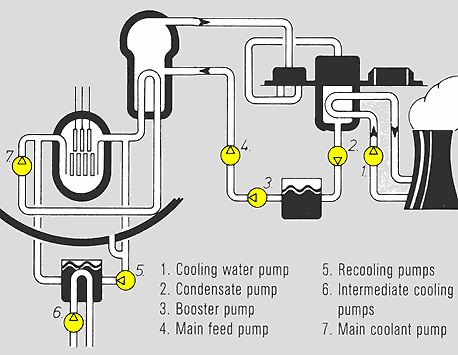| Pressurized water reactor | ||
A thermal nuclear power station which used light water
(light water reactor nuclear reactor) at pressures up to
approximately 170 bar. The water employed to dissipate the heat of nuclear fission
and to retard the neutrons released by splitting nuclei (moderation) is demineralized and
treated with chemicals to enable it to serve as coolant for the reactor. Proper
coordination of system pressure and temperature prevents the coolant from vaporizing,
enabling the intensive cooling effect of the pressurized water to be utilized to the full.
|
After the feed water condenses in the condenser, it is recycled to the steam generators (secondary circuit). Separating the reactor cooling circuit (primary circuit) and the water steam circuit (secondary circuit) is an advantage (as compared with e. g. boiling water reactors) for pumps and their mechanical seals, because far fewer of them – only those of the primary circuit are contaminated (radioactively). The feed water pumps, booster pumps, and main and secondary condensate pumps (condensate pumps) are among those pumps which remain uncontaminated. All pumps in a pressurized water reactor are equipped with mechanical seals. |
|
Schematic presentation of a pressurized water reactor with
its principal pumps |
||